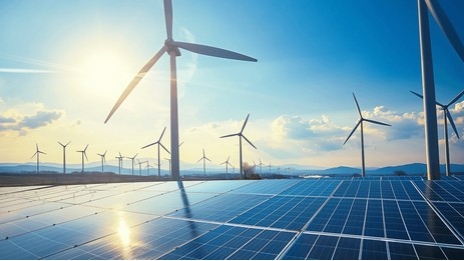
Wind And Solar Electricity Producer :
India is currently the world’s second-largest producer of renewable energy, with a capacity of more than 200 gigawatts (GW), according to a report by global energy think-tank Ember.
Wind And Solar Electricity Producer
The National Action Plan on Climate Change was introduced in 2010, marking the beginning of the nation’s transition to renewable energy in earnest. Around 60% of India’s energy mix at the time came from coal, which dominated the country’s energy landscape. But in the last ten years, India has made great progress in increasing its capacity for renewable energy, establishing challenging goals and investing heavily in wind and solar energy.
“In comparison, India generated 22 per cent of its electricity from clean sources in 2024, with hydropower as the single largest contributor at 8 per cent of the mix, while wind and solar made up 10%,” the report stated.
As part of its commitment to the Paris Agreement, India set a goal in 2015 to have 175 GW of renewable energy capacity by 2022. This goal was later increased to 500 GW by 2030. In order to achieve these objectives, large-scale solar projects like those in Rajasthan and Gujarat as well as sizable wind farms along its coastal states like Tamil Nadu and Andhra Pradesh have been essential.
Renewable energy is now more widely available and reasonably priced in India thanks to technological developments, falling solar and wind turbine prices, and supportive government policies like financial incentives and competitive auctions. As a result, the nation is now among the most affordable markets for renewable energy in the world.
Wind And Solar Electricity Producer
India has been referred to as a “solar superpower” by UN climate chief Simon Stiell, who also stated that the country’s economic growth would be further accelerated if it fully embraced the global clean energy boom. India promised to attain 50% of its installed electric power capacity from non-fossil sources by 2030 in its Nationally Determined Contributions (NDCs) to the UNFCCC in 2022. The government also declared in 2021 that it would reach 500 GW of non-fossil capacity by 2030. This goal is mentioned in important policy documents such as the 14th National Electricity Plan, but it is not explicitly included in the NDCs.
In addition to enhancing its energy security, India’s ascent to the position of third-largest producer of solar and wind energy is also vital to the global effort to tackle climate change. India is one of the biggest emitters of greenhouse gases, so achieving net-zero emissions by 2050 and other global climate goals depends on its transition to clean energy.
With continued investments and encouraging policies, India’s renewable energy future appears bright, despite obstacles like grid integration and energy storage. This strengthens India’s position as a major player in the global energy transition.
This post photo and Information collect by Ananya Paul Oneindia.
Important Link : Jobcrypko
| Join Our WhatsApp group | Click Here |
| Join Our Facebook Group | Click Here |

